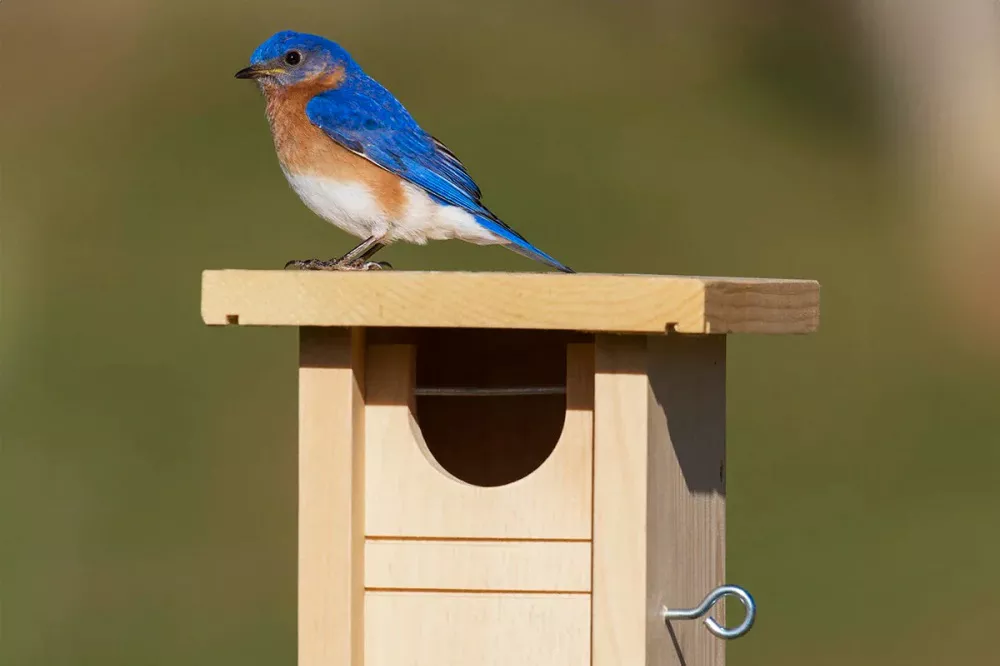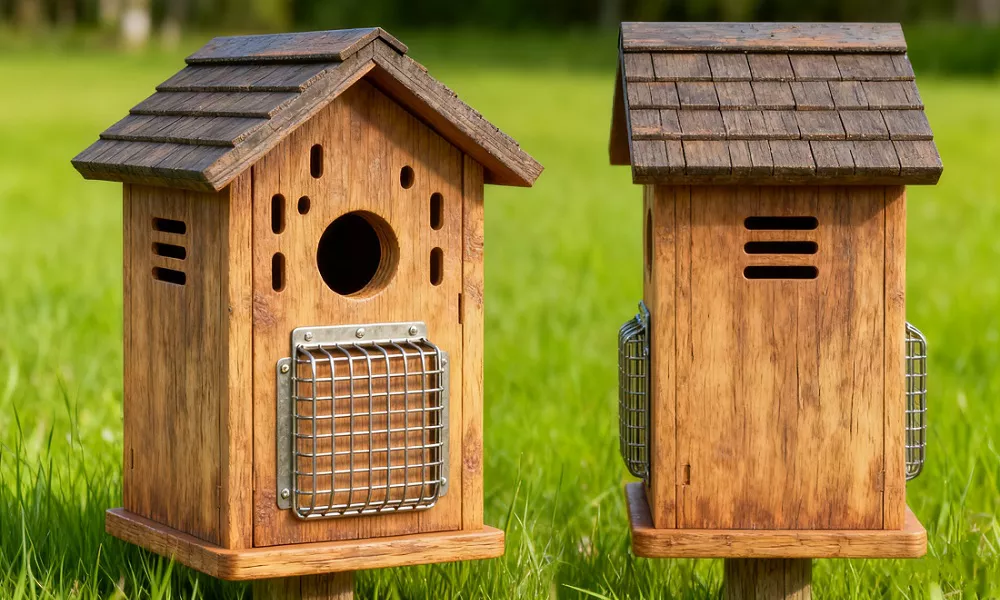Bluebirds are a beloved species known for their vibrant plumage and charming presence. Many bird enthusiasts aim to attract these birds to their backyards by providing suitable habitats. One of the best ways to do this is by setting up a bluebird house. Whether you’re a seasoned birdwatcher or a beginner, understanding the key features of bluebird houses and selecting the right plan is essential to attracting these beautiful birds. In this article, we’ll explore the five best bluebird house plans that will help you create a perfect, safe environment for bluebirds in your backyard.
Why Bluebird Houses Are Important
Bluebird houses are essential for the survival of these birds, particularly in areas where natural nesting sites, like tree cavities, are scarce. These houses provide a safe place for bluebirds to build their nests, raise their young, and find protection from predators. Bluebirds, especially species like the Eastern Bluebird and Western Bluebird, rely on human-made houses to thrive, especially in suburban and rural areas.
What Makes the Perfect Bluebird House?
Before diving into the plans, it’s important to understand what makes a bluebird house ideal:
Entrance hole size: Bluebird houses should have an entrance hole large enough to accommodate bluebirds but small enough to keep out larger, more aggressive birds like starlings.
Ventilation and drainage: Proper air circulation and water drainage are crucial for maintaining a healthy and dry environment.
Predator protection: Bluebird houses should be designed to minimize the risk of predators such as raccoons, squirrels, or snakes.
Materials: Wood is typically the best material for constructing bluebird houses, as it provides natural insulation and is durable against the elements.
With these factors in mind, let’s look at five bluebird house plans that incorporate these key elements for success.
See Also: What Size Hole For Bluebird House?
1. Classic Wooden Bluebird House Plan
Best For: Beginners
A simple and traditional wooden bluebird house is a timeless choice. This classic design features a basic rectangular shape with a round entrance hole. The roof is slanted to shed rainwater, and the walls are sturdy yet breathable, allowing airflow for the nesting birds.
Features:
- Dimensions: Typically 5.5 inches by 5.5 inches for the floor, and about 10 inches tall.
- Entrance hole: 1.5 inches in diameter to prevent larger birds from entering.
- Ventilation holes: Small holes near the top for air circulation.
- Predator guard: An optional metal or wooden predator guard around the entrance to deter squirrels and other creatures.
This plan is excellent for anyone just starting out because it’s easy to build, requires minimal tools, and provides a safe space for bluebirds.
2. Cedar Bluebird House Plan with Removable Roof
Best For: Experienced Woodworkers
This bluebird house plan adds a unique twist by incorporating a removable roof for easy cleaning after the nesting season. Made from cedar wood, it’s resistant to rot and has a natural scent that deters pests.
Features:
- Materials: High-quality cedar wood, known for its durability and pest resistance.
- Removable roof: Makes cleaning the house at the end of each nesting season easier.
- Dimensions: Similar to the classic plan, with a 5.5-inch square base and a 10-inch height.
- Ventilation: Vent holes in the top and bottom of the house for maximum airflow.
This plan is perfect for those who want to ensure that the house remains hygienic and safe for successive generations of bluebirds.
3. Deluxe Bluebird House with Predator Guard
Best For: Homeowners in areas with high predator activity
Predator protection is an important consideration for any birdhouse. This deluxe bluebird house plan includes a special predator guard around the entrance and on the roof to keep squirrels, raccoons, and other predators away. The house is built from pressure-treated wood, making it resilient to weather conditions.
Features:
- Predator guard: A metal mesh or wooden extension around the entrance to prevent larger birds or animals from entering.
- Dimensions: A slightly larger 6-inch base, with a height of about 12 inches.
- Roof: A slanted roof with an extended lip to further protect against predators.
- Maintenance: The house includes a hinged side panel for easy access during cleaning.
This design is ideal for bluebird enthusiasts who live in areas where predators are a concern and want to ensure that the bluebirds remain safe.
See Also: What Does a BlueBird Sound Like?
4. Modern PVC Bluebird House Plan
Best For: People looking for low-maintenance options
PVC is an increasingly popular material for birdhouses because it is low-maintenance, easy to clean, and highly durable. This modern bluebird house plan uses PVC pipes and panels to create a sleek and functional home for bluebirds. It resists moisture and is long-lasting, even in harsh weather conditions.
Features:
- Material: High-quality, weather-resistant PVC.
- Design: A contemporary design with a rectangular shape and small, round entrance hole.
- Dimensions: A 6-inch by 6-inch floor, and a 12-inch height.
- Ventilation: Small holes near the top and bottom for proper airflow.
The PVC material also resists insects and decay, making it perfect for birders who want a hassle-free option that requires little upkeep.
5. Customizable Wooden Bluebird Mansion
Best For: Advanced DIYers or birdhouses for multiple families
This is a larger and more complex plan, ideal for those who have the space to house more than one pair of bluebirds. This design allows for customization, with multiple compartments and a larger roof to offer protection to multiple nests. It’s the ideal option for people with larger properties or those who want to support multiple bluebird families.
Features:
- Multiple compartments: The house is divided into separate sections with individual entrances for different bluebird pairs.
- Dimensions: Each compartment is about 5.5 inches square, with a larger, 18-inch tall house.
- Material: Made from high-quality treated wood, ensuring it lasts for many seasons.
- Ventilation and drainage: Each compartment is fully ventilated, with drainage holes in the base.
This plan is best suited for bird lovers who have a significant amount of space and are interested in creating a small bluebird community in their yard.
How to Choose the Right Bluebird House Plan
Selecting the best bluebird house plan depends on various factors, including your location, the predators in your area, and your personal preferences. For example:
- If you live in a predator-heavy area, a house with a predator guard (like the Deluxe Bluebird House) is a must.
- For low maintenance, a PVC house can be an excellent choice as it’s weatherproof and easy to clean.
- Beginners may prefer a classic wooden bluebird house that is simple to build and maintain.
Ultimately, providing the perfect home for bluebirds involves not just building a good house, but placing it in the right environment. Ensure your bluebird house is mounted in a quiet, sheltered spot away from high traffic areas and predators.
Conclusion
Providing bluebirds with a safe and cozy home is a rewarding experience that benefits both the birds and the backyard gardener. By choosing one of these 5 bluebird house plans, you can create a welcoming sanctuary that helps preserve this beautiful species. Whether you’re a novice or an experienced DIYer, there’s a plan for every level of expertise and backyard space. So, grab your tools, pick the perfect plan, and start building a home for your local bluebirds today!
FAQs About Bluebird Houses
Which direction should a bluebird house face?
Bluebird houses should face east or southeast. This orientation protects the entrance from prevailing winds and afternoon heat, helping maintain a stable and comfortable nest temperature.
How do you make a simple bluebird house?
A simple bluebird house can be made using untreated wood, a 1.5-inch entrance hole, and proper ventilation and drainage. Use a single board or basic panels, assemble with screws, avoid perches, and include a side-opening panel for easy cleaning. Stick to a 5×5 inch floor, 8–12 inch interior height, and a sloped roof that extends over the hole.
Where’s the best place to put a bluebird house?
Place the house in a wide, open area with short grass, preferably near fields, meadows, or open lawns. Mount it 4–6 feet above the ground, facing away from strong winds. Keep it at least 300 feet away from other bluebird houses to reduce territorial conflicts.
When should you put up bluebird houses?
Install bluebird houses in late winter or early spring, ideally from February to March, before the breeding season begins. However, leaving the box up year-round is fine, as bluebirds often investigate sites early and may use the box for winter roosting.
What are the requirements for a bluebird house?
A proper bluebird house should include:
- 1.5-inch entrance hole for Eastern and Mountain Bluebirds (1 9/16 inches for Western Bluebirds)
- Interior floor size around 5×5 inches
- Height of 8–12 inches
- No perch (deters predators and invasive species)
- Ventilation and drainage holes
- A predator guard or baffle if possible
- Easy access for cleaning
- Mounting pole or post rather than a tree, to reduce predation







 Facebook
Facebook  Instagram
Instagram  Youtube
Youtube 